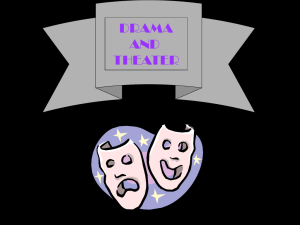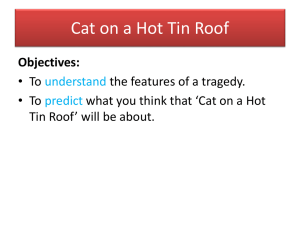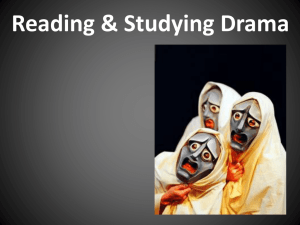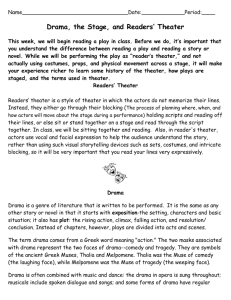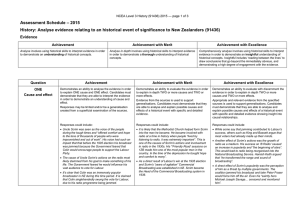AP English Boyd 1 GLOSSARY OF LITERARY TERMS DRAMA
advertisement
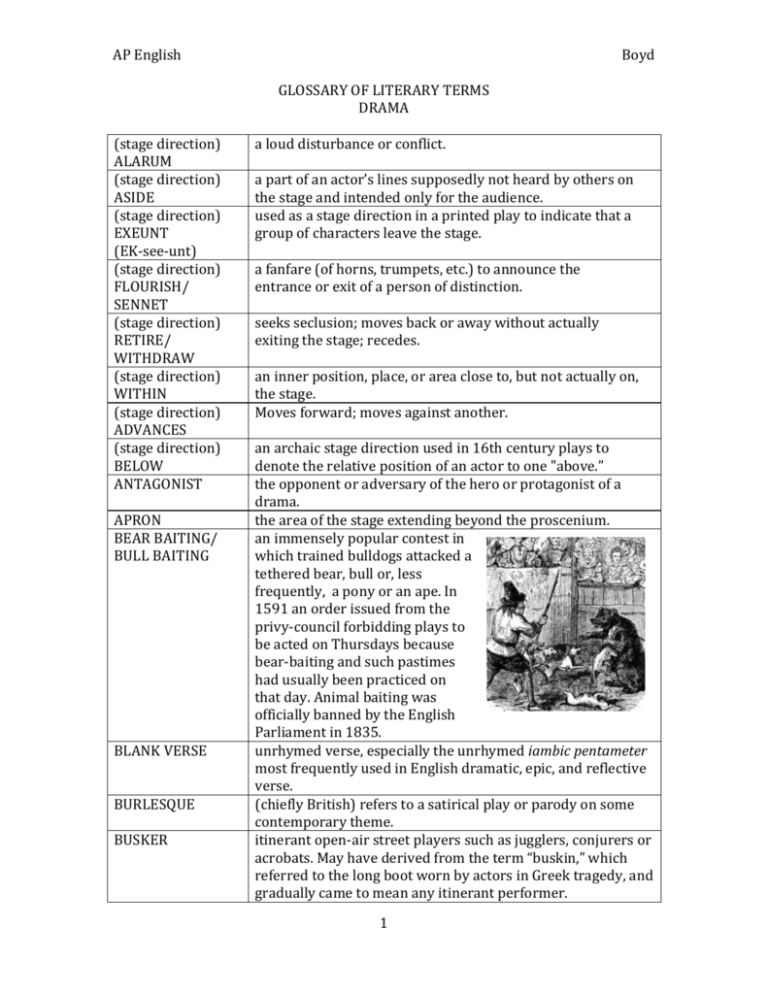
AP English (stage direction) ALARUM (stage direction) ASIDE (stage direction) EXEUNT (EK-­‐see-­‐unt) (stage direction) FLOURISH/ SENNET (stage direction) RETIRE/ WITHDRAW (stage direction) WITHIN (stage direction) ADVANCES (stage direction) BELOW ANTAGONIST APRON BEAR BAITING/ BULL BAITING BLANK VERSE BURLESQUE BUSKER Boyd GLOSSARY OF LITERARY TERMS DRAMA a loud disturbance or conflict. a part of an actor’s lines supposedly not heard by others on the stage and intended only for the audience. used as a stage direction in a printed play to indicate that a group of characters leave the stage. a fanfare (of horns, trumpets, etc.) to announce the entrance or exit of a person of distinction. seeks seclusion; moves back or away without actually exiting the stage; recedes. an inner position, place, or area close to, but not actually on, the stage. Moves forward; moves against another. an archaic stage direction used in 16th century plays to denote the relative position of an actor to one "above.” the opponent or adversary of the hero or protagonist of a drama. the area of the stage extending beyond the proscenium. an immensely popular contest in which trained bulldogs attacked a tethered bear, bull or, less frequently, a pony or an ape. In 1591 an order issued from the privy-­‐council forbidding plays to be acted on Thursdays because bear-­‐baiting and such pastimes had usually been practiced on that day. Animal baiting was officially banned by the English Parliament in 1835. unrhymed verse, especially the unrhymed iambic pentameter most frequently used in English dramatic, epic, and reflective verse. (chiefly British) refers to a satirical play or parody on some contemporary theme. itinerant open-­‐air street players such as jugglers, conjurers or acrobats. May have derived from the term “buskin,” which referred to the long boot worn by actors in Greek tragedy, and gradually came to mean any itinerant performer. 1 AP English CATHARSIS (kuh-­‐THAR-­‐sus) Boyd in Aristotle's Poetics, the “purging” or “cleansing” of terror and pity, which the audience develops during the climax of a tragedy. COUPLET a pair of lines of meter in poetry; it usually consists of two lines that rhyme and have the same meter. CUCKOLD the husband of an unfaithful wife (can also be used as a verb); the cuckold grows horns. DENOUEMENT the final scene or scenes in a play devoted to tying up the (day-­‐noo-­‐MAH) loose ends after the climax (although the word originally meant "the untying"). DEUS EX MACHINA Literally, the god from the machine. Refers to the character (day-­‐us eks (usually a god) in classical Greek tragedy who enters the play MAH-­‐kuh-­‐nuh) from the heavens at the end of the drama to resolve or explain the conflict. This actor was usually lowered by means of a crane-­‐like device known as a mechane. The term has come to mean any arbitrary means of plot resolution. FALSE also known as the inner proscenium, this is a temporary PROSCENIUM structure used to reduce the opening of the permanent proscenium. Particularly useful for touring companies, where the troupe has to play on a variety of stage sizes. FARCE highly comic, lighthearted, gleefully contrived drama, usually involving stock situations (such as mistaken identity or discovered lovers’ trysts), punctuated with broad physical stunts and pratfalls. FOURTH WALL the imaginary fourth wall that is removed from box set to enable the audience to see the action on stage. The term now applies to the “wall” separating audience and performers on any type of stage or even film and television. Thus, the term “breaking the fourth wall” refers to an actor speaking directly to the audience. HAMARTIA the flaw in character which leads to the downfall of the (hah-­‐mar-­‐TEE-­‐uh) protagonist in a tragedy; “tragic flaw.” HARLEQUIN perhaps the best-­‐known stock character to have originated from the Commedia dell'Arte. Originally a sharp-­‐witted servant in Italy, he became a simpleton in France and a lackadaisical lover in the British Theater. Best recognized by his tight-­‐fitting suit of silk diamonds in contrasting colors. HUBRIS (also spelled hybris) excessive pride or self-­‐confidence; (HEW-­‐brus) arrogance. IAMBIC the most common meter in English verse; it consists of a line PENTAMETER ten syllables long that is accented on every second beat. JONGLEUR itinerant entertainers of the medieval period in Europe. The (zhong-­‐LOOr) term embraces ballad-­‐singers, acrobats, jugglers, and animal trainers. 2 AP English JOURNEYMAN MACHIAVEL (MAK-­‐yuh-­‐vel) MASQUE MUSES PATHOS (PAY-­‐thoze) PLAY-­‐WITHIN-­‐ THE-­‐PLAY PROSCENIUM ARCH (proh-­‐SEEN-­‐ee-­‐ yum) PROTAGONIST Boyd in Elizabethan theater, members of a company who both acted and held an ownership interest in the company. Journeymen worked under a master in much the same manner as they had in medieval guilds. a type of stage villain found in Elizabethan and Jacobean drama; a broad category of ruthless schemers, atheists, and poisoners. form of entertainment during the late middle ages, Renaissance through the Reformation, which combined poetry, music, scenery and elaborate costumes. Like mystery plays and pageants, masques constitute a connection between classical theater and modern theater. Masques grew out of folk ritual in which guests would visit a nobleman or king and deliver gifts on some special occasion or holiday. In masques during the 17th Century, it was not unusual for royalty to participate in masques an oft-­‐cited example being Louis XIV's portrayal of the Sun-­‐King in the Ballet Nuit. there were nine muses in Greek mythology -­‐-­‐ the daughters of Mnemosyne, the goddess of memory. Three of these were particularly connected with theater: Melpomene, the muse of tragedy; Terpischore, the muse of dancing; and Thalia, the muse of comedy. “passion,” in Greek; also “suffering.” The word refers to the depths of feeling evoked by tragedy; it is at the root of our words “sympathy” and “empathy,” which also describe the effect of drama on audience emotions. a play that is “presented” by characters who are already in a play; like “The Murder of Gonzago,” which is presented by “players” in Hamlet. Many plays are in part about actors and plays and contain such plays-­‐within-­‐plays; these include Anton Chekhov's Seagull, Jean Anouilh's Rehearsal, and Shakespeare's Midsummer Night's Dream and Taming of the Shrew. the arch that frames a stage, separating it from the auditorium. the leading actor of a play, who is often set in conflict with an antagonist. The term derives from ancient Greek theater in which it described the first actor to speak. Originally, Greek theater consisted of one principal actor and a chorus. As two and then three actors were added, they were referred to as the Protagonist, Deuteragonist, and Tritagonist. 3 AP English RAKED STAGE SCRIM SHARERS SOLILOQUY SUBPLOT SUSPENSION OF DISBELIEF TABLEAU THREE UNITIES Boyd a sloped stage, angled so that the rear (upstage) area is higher than the forward (downstage) area. A raked stage was standard theatre architecture in the seventeenth century and is often used today in scene design but rarely in a theatre's permanent architecture. a loosely woven material used on stage, often to represent glass or some other transparent substance. If lighting is thrown on the front of a scrim drop, with no lighting behind, it becomes opaque. If lighting on the front is reduced and the scrim is lit from behind, it becomes transparent to the audience. Lighting can therefore be used to “remove” a wall and permit the audience to see the action on the other side, while understanding that they are seeing “through” the wall. An example of this can be seen in South Pacific during the follies when backstage area of the follies plays downstage in front of a scrim and the actual “performance” takes place upstage, behind the scrim. By changing the lighting, the scene can be shifted from action taking place “backstage” to that “onstage.” term from Elizabethan theater to describe those members of the company who owned a part interest in the wardrobe and playbooks, as opposed to apprentices, who were not paid, and hired men, who paid a fixed wage. an utterance or discourse by a person who is talking to himself or herself or is disregardful of or oblivious to any hearers present (often used as a device in drama to disclose a character’s innermost thoughts). a secondary plot in a play, usually related to the main plot by play's end. The Gloucester plot in King Lear and the Laertes plot in Hamlet are examples. the goal of any theater company in presenting or performing a play is to cause the audience to suspend their disbelief, or to momentarily forget that what they are watching is a performance, but is, in an emotional sense, “real.” a “frozen moment” onstage, with the actors immobile, usually employed at the end of a scene, as the curtain falls or the lights dim. unities of time, place and action, the three elements of drama introduced into French dramatic literature is actually based on a misinterpretation of Aristotle's Poetics. They demanded that a play should consist of one action, represented as occurring in not more than 24 hours, and always in the same 4 AP English VERISIMILITUDE place. According to The Concise Oxford Companion to the Theatre, Aristotle “insists only on the unity of action, merely mentions the unity of time, and says nothing about the unity of place.” The influence of Shakespeare in England was such that the three unities were never adopted as a rule of dramatic construction. the appearance of truth. The value that players strive for in their attempt to suspend the audience's disbelief. This is not to be confused with realism or naturalism, for the depiction of truth can take form even in symbolic works. Boyd 5
